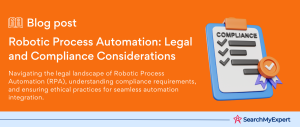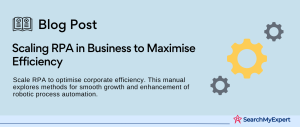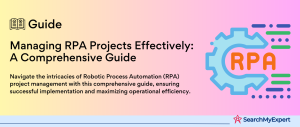Understanding Robotic Process Automation and the Critical Need for Governance
Robotic Process Automation (RPA) is a transformative technology that automates routine, manual tasks using software robots, or ‘bots’. These bots mimic human actions to perform a wide range of tasks, from simple data entry to complex analytical processes. The main allure of RPA lies in its ability to streamline operations, reduce errors, and enhance efficiency, making it a valuable asset in today’s fast-paced business environment.
Benefits of RPA: A Game Changer in Business Efficiency
RPA offers numerous advantages, making it an essential tool for modern businesses:
- Increased Efficiency: Automating repetitive tasks speeds up processes and eliminates human error.
- Cost Reduction: RPA reduces labor costs and the need for manual intervention.
- Scalability:
RPA can easily adjust to fluctuating workloads, providing flexibility. - Enhanced Accuracy: Bots perform tasks with precision, leading to improved data quality.
- Employee Empowerment:
By automating mundane tasks, RPA allows employees to focus on more strategic, value-added activities.
The Imperative of RPA Governance
Despite its benefits, RPA also brings challenges, particularly in managing and controlling its deployment. RPA governance is crucial for ensuring that the implementation of RPA is aligned with business objectives, compliant with regulations, and effective in delivering expected outcomes. Without proper governance, organizations risk bot mismanagement, security vulnerabilities, and suboptimal performance.
Key Elements of Successful RPA Governance Framework
A robust RPA governance framework should include the following components:
- Strategic Alignment: Ensuring RPA initiatives align with the overall business strategy and objectives.
- Policy and Standards:
Establishing clear policies and standards to guide RPA development and deployment. - Change Management: Managing the organizational changes brought about by RPA, including workforce transition and training.
- Risk and Compliance Management:
Identifying and mitigating risks, ensuring compliance with legal and regulatory requirements. - Performance Monitoring:
Continuously monitoring the performance of RPA bots to ensure they are delivering desired results.
Benefits of Robotic Process Automation Governance
Robotic Process Automation (RPA) governance is not just a regulatory necessity but a strategic asset. Effective governance enhances the potential of RPA, turning it into a powerhouse for business efficiency and risk management. Below, we explore the multifaceted benefits of implementing robust RPA governance in an organization.
Boosting Process Efficiency and Accuracy
- Streamlined Operations:
RPA governance ensures that bots are deployed strategically, leading to more streamlined and efficient processes. - Precision in Task Execution: With proper oversight, RPA can achieve higher accuracy in tasks, minimizing errors and improving output quality.
Mitigating Errors and Compliance Issues
- Error Reduction:
By setting standards for bot development and deployment, governance reduces the likelihood of errors in automated processes. - Compliance Assurance:
It ensures adherence to regulatory requirements, thereby minimizing legal and financial risks associated with non-compliance.
Promoting Transparency and Accountability
- Visibility into Operations: Governance frameworks establish protocols for monitoring and reporting, enhancing visibility into automated processes.
- Clear Accountability:
By delineating roles and responsibilities, it ensures accountability for the outcomes of RPA initiatives.
Strengthening Security and Data Protection
- Robust Security Measures: Governance frameworks include security protocols to protect against unauthorized access and data breaches.
- Data Integrity: Ensuring the integrity and confidentiality of data handled by RPA bots is a key component of RPA governance.
Optimizing Resource Allocation and Utilization
- Efficient Use of Resources:
Governance helps in identifying the most beneficial areas for RPA application, ensuring optimal use of organizational resources. - Maximizing ROI:
By aligning RPA initiatives with business goals, governance frameworks help in achieving a higher return on investment.
Crafting a Robust RPA Governance Framework
Robotic Process Automation (RPA) is not a set-it-and-forget-it technology. To reap its full benefits, a meticulously planned governance framework is essential. Here we break down the key elements of an effective RPA governance framework, ensuring that your RPA journey is both smooth and rewarding.
Process Identification and Selection
- Criteria Definition: Establish clear criteria for selecting processes suitable for RPA. This includes assessing the complexity, volume, and variability of tasks.
- Feasibility and Cost-Benefit Analyses: Conduct thorough studies to evaluate the feasibility and potential benefits of automating specific processes.
RPA Development and Implementation
- Development Standards:
Set standards and guidelines for RPA bot development to ensure consistency and quality. - Quality Assurance and Testing: Implement rigorous testing procedures to ensure bots function as intended without errors.
- Roles and Responsibilities: Clearly define who is responsible for various aspects of RPA development and deployment.
Monitoring and Control
- Performance Tracking:
Utilize monitoring tools and metrics to assess the effectiveness of RPA bots. - Exception Handling: Establish procedures for managing exceptions and escalation processes for unforeseen issues.
- Audit Procedures: Regularly audit RPA activities to ensure compliance with governance standards.
Security and Compliance
- Data Protection:
Implement robust security measures to safeguard sensitive data and systems involved in RPA processes. - Regulatory Compliance: Ensure all RPA activities comply with relevant laws and industry standards.
- Incident Response:
Develop procedures for responding to security incidents involving RPA tools.
Change Management
- Stakeholder Communication: Create a communication plan to keep all stakeholders informed about RPA initiatives.
- Employee Training: Offer training programs to upskill employees affected by RPA deployment.
- Managing Resistance: Develop strategies to address and mitigate resistance to change among employees.
Continuous Improvement
- Framework Review and Update:
Regularly revisit the RPA governance framework to incorporate new insights and improvements. - Expansion Opportunities:
Identify new areas where RPA can be beneficially applied. - ROI Measurement: Continuously measure the return on investment to justify and guide future RPA endeavors.
Implementing RPA Governance
Implementing Robotic Process Automation (RPA) governance is a critical step in ensuring the success and sustainability of your RPA initiatives. Here’s a detailed roadmap to help you effectively implement RPA governance in your organization.
Defining the Scope of RPA Governance
- Scope Identification: Determine the breadth of your RPA governance program. This includes identifying which processes, departments, and systems will be governed by the RPA framework.
- Objectives Setting: Clearly define the objectives of your RPA governance program, such as enhancing efficiency, ensuring compliance, or improving data security.
Establishing a Governance Body or Committee
- Committee Formation: Create a dedicated governance body or committee responsible for overseeing RPA initiatives. This team should include representatives from IT, business units, compliance, and other relevant departments.
- Roles and Responsibilities: Assign specific roles and responsibilities to members of the governance body, ensuring clear accountability.
Developing and Implementing Policies and Procedures
- Policy Creation:
Develop comprehensive policies and procedures for RPA implementation and management. This should cover aspects like bot development, data handling, and risk management. - Implementation Strategy: Create a plan for implementing these policies across the organization, ensuring they are integrated into existing business processes.
Training Your Employees on RPA Governance
- Training Programs:
Develop training modules to educate employees about RPA governance policies, the importance of compliance, and their roles in the governance process. - Continuous Learning:
Encourage ongoing learning and adaptation as RPA technologies and best practices evolve.
Monitoring and Auditing Your RPA Program
- Performance Monitoring: Implement tools and techniques to monitor the performance and efficiency of RPA bots regularly.
- Regular Audits:
Conduct periodic audits to ensure adherence to governance policies and to identify areas for improvement. - Feedback Mechanism:
Establish a feedback loop to gather insights from employees and stakeholders, which can be used to refine the RPA governance framework.
Navigating the Challenges of RPA Governance
While Robotic Process Automation (RPA) promises significant benefits, implementing its governance framework is not without challenges. Understanding and addressing these challenges is crucial for the success of RPA initiatives. Here, we explore common obstacles and offer strategies to overcome them.
Overcoming Lack of Awareness and Understanding
- Educational Initiatives:
Conduct workshops and training sessions to educate employees about RPA and its benefits. - Information Dissemination:
Use internal communication channels to regularly share information about RPA projects and their impact.
Addressing Resistance to Change
- Engaging Employees: Involve employees in the RPA process, from planning to implementation, to create a sense of ownership.
- Highlighting Benefits:
Emphasize how RPA can simplify tasks and improve job satisfaction by reducing mundane work.
Tackling Insufficient Resources
- Strategic Resource Allocation: Prioritize projects and allocate resources based on potential impact and feasibility.
- Seeking External Support:
Consider partnering with RPA consultants or vendors for expert guidance and additional resources.
Measuring ROI of RPA
- Defining KPIs: Establish clear Key Performance Indicators (KPIs) to measure the success of RPA initiatives.
- Continuous Monitoring: Implement a system for ongoing tracking and assessment of RPA’s financial and operational impact.
Best Practices for Effective RPA Governance
Robotic Process Automation (RPA) governance is a journey that requires careful planning, execution, and continuous refinement. To maximize the value and sustainability of your RPA initiatives, here are some best practices to follow:
Starting Small and Scaling Gradually
- Pilot Projects: Begin with small-scale pilot projects to test and refine your RPA strategy before full-scale implementation.
- Incremental Expansion:
Gradually expand the scope of RPA to other processes and departments, learning from initial experiences.
Focusing on High-Impact Processes
- Identifying Key Areas: Prioritize processes that offer significant benefits in terms of efficiency, cost savings, or customer satisfaction.
- Value-Based Implementation:
Focus RPA deployment on areas that promise the highest return on investment and strategic value.
Involving Stakeholders in the Governance Process
- Collaborative Approach: Engage various stakeholders, including IT, operations, and executive leadership, in the governance process.
- Regular Feedback:
Encourage continuous feedback from users and stakeholders to identify areas for improvement.
Communicating Effectively About RPA
- Transparent Communication:
Maintain open and regular communication about RPA goals, progress, and outcomes. - Educational Content:
Provide resources and training to demystify RPA and build organization-wide understanding.
Continuously Improving Your RPA Governance Program
- Regular Reviews:
Periodically review and update your RPA governance framework to align with evolving business needs and technological advancements. - Innovation Encouragement:
Foster a culture of innovation, encouraging employees to identify new opportunities for RPA application.
Embracing RPA Governance for Future-Proof Success
As we wrap up our exploration of Robotic Process Automation (RPA) governance, it’s clear that effective governance is not just an operational necessity but a strategic enabler for organizations looking to harness the full potential of RPA.
Recapping the Importance of RPA Governance
RPA governance stands as the cornerstone of successful RPA implementation. It ensures that RPA initiatives are aligned with business objectives, compliant with regulatory standards, and effective in delivering tangible benefits. With governance, organizations can mitigate risks, enhance process efficiency, and foster a culture of continuous improvement and innovation.
Recommendations for Implementing RPA Governance
- Strategic Planning: Begin with a clear strategy that aligns with your organization’s goals and objectives.
- Stakeholder Engagement: Involve key stakeholders from various departments to ensure broad support and understanding.
- Resource Allocation:
Dedicate adequate resources, including personnel and technology, for the governance program. - Continuous Education: Keep the workforce informed and educated about RPA and its governance to foster a supportive environment.
- Performance Tracking: Regularly monitor and evaluate the performance of RPA initiatives to ensure they meet their intended goals.
- Adaptability:
Stay adaptable to changes in technology and business processes to continually refine your RPA strategy.
Resources for Further Information
To deepen your understanding and stay updated with the latest trends and best practices in RPA governance, consider the following resources:
- RPA Industry Reports:
Regularly review industry reports and whitepapers for insights into evolving trends and strategies. - Professional Courses: Enroll in courses or webinars focused on RPA governance and management.
- Networking Groups:
Join professional networks or online communities dedicated to RPA to exchange ideas and experiences. - Consulting Experts:
Seek advice from RPA consultants or experts who can provide tailored guidance based on your organization’s specific needs.
Conclusion
Effective Robotic Process Automation (RPA) governance is essential for harnessing the full potential of RPA technologies. By establishing clear strategies, involving stakeholders, allocating necessary resources, and continuously educating and monitoring performance, organizations can overcome challenges and ensure successful implementation. RPA governance not only streamlines processes and reduces risk but also aligns RPA initiatives with broader business objectives. Embracing these practices allows organizations to navigate the complexities of RPA, leading to enhanced efficiency, compliance, and a culture of continuous innovation.
Optimize your operations with our expert Robotic Process Automation Company.
Further Reading
Table of Contents
Toggle






